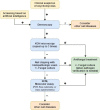Diagnosis of Onychomycosis: From Conventional Techniques and Dermoscopy to Artificial Intelligence
- PMID: 33937282
- PMCID: PMC8081953
- DOI: 10.3389/fmed.2021.637216
Diagnosis of Onychomycosis: From Conventional Techniques and Dermoscopy to Artificial Intelligence
Abstract
Onychomycosis is a common fungal nail infection. Accurate diagnosis is critical as onychomycosis is transmissible between humans and impacts patients' quality of life. Combining clinical examination with mycological testing ensures accurate diagnosis. Conventional diagnostic techniques, including potassium hydroxide testing, fungal culture and histopathology of nail clippings, detect fungal species within nails. New diagnostic tools have been developed recently which either improve detection of onychomycosis clinically, including dermoscopy, reflectance confocal microscopy and artificial intelligence, or mycologically, such as molecular assays. Dermoscopy is cost-effective and non-invasive, allowing clinicians to discern microscopic features of onychomycosis and fungal melanonychia. Reflectance confocal microscopy enables clinicians to observe bright filamentous septate hyphae at near histologic resolution by the bedside. Artificial intelligence may prompt patients to seek further assessment for nails that are suspicious for onychomycosis. This review evaluates the current landscape of diagnostic techniques for onychomycosis.
Keywords: artificial intelligence; dermoscopy; diagnosis; diagnostic imaging; fungi; onychomycosis; pathology; reflectance confocal microscopy.
Copyright © 2021 Lim, Ohn and Mun.
Conflict of interest statement
The authors declare that the research was conducted in the absence of any commercial or financial relationships that could be construed as a potential conflict of interest.
Figures


References
-
- Ghannoum MA, Hajjeh RA, Scher R, Konnikov N, Gupta AK, Summerbell R, et al. . A large-scale North American study of fungal isolates from nails: the frequency of onychomycosis, fungal distribution, and antifungal susceptibility patterns. J Am Acad Dermatol. (2000) 43:641–8. 10.1067/mjd.2000.107754 - DOI - PubMed
-
- Gupta AK, Gupta G, Jain HC, Lynde CW, Foley KA, Daigle D, et al. . The prevalence of unsuspected onychomycosis and its causative organisms in a multicentre Canadian sample of 30 000 patients visiting physicians' offices. J Eur Acad Dermatol Venereol. (2016) 30:1567–72. 10.1111/jdv.13677 - DOI - PubMed
Publication types
LinkOut - more resources
Full Text Sources
Other Literature Sources

